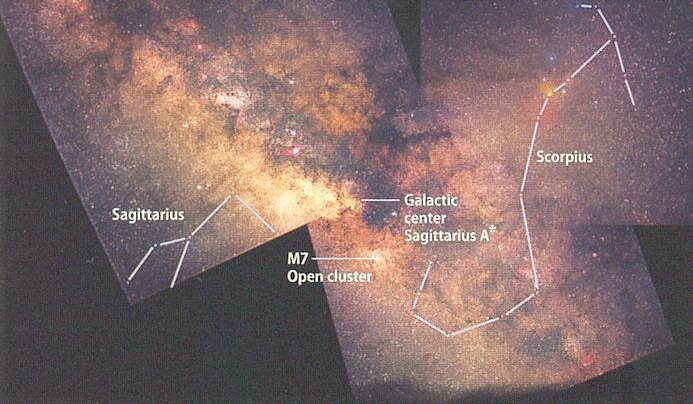
| Home Page | Overview | Site Map | Index | Appendix | Illustration | About | Contact | Update | FAQ |
 |
It is found recently that the central black hole invariably comprises about 0.5% of the mass of the stars in the spheroid of the galaxies. This is referred to as the Magorrian relation, the same relationship is also applicable to the black holes in some globular clusters. A galaxy's spheroid is the round central bulge in a spiral galaxy, or the whole galaxy with an elliptical. It seems that once the black hole reaches a particular maximum mass, it would shut off its own growth by forcing orbits of surrounding stars to become more circular. This keeps them out of the black hole's powerful grip. If this process happened commonly, most galaxies must have undergone a bright quasarlike phase in their youth, when the central black hole was growing by ingesting material and producing quasarlike symptoms. |
Figure 05-16g Sagittarius |
 |
The development of a central black hole may be an unavoidable part of a galaxy's formation and evolution. The black hole at the Milky Way center is located at SgrA* toward a point in the constellation Sagittarius (Figure 05-16g). It shows no sign of motion, has a mass of 4 million suns, its size is smaller than the solar system and is in a much quieter phase comparing to the AGN's or quasars. The upper portion of Figure 05-17a shows a 400 by 900 light-years mosaic of Chandra X-ray images toward the central region of the Milky Way. It reveals thousands of white dwarf stars, neutron stars, and black holes bathed in an incandescent fog of multimillion-degree gas. The supermassive black hole at the Milky Way center is located inside the bright white patch at the center of the image. The colors indicate X-ray energy bands - red (low), green (medium), and blue (high). The lower part of Figure 05-17a is a blow-up of the central region. It shows four (A-D) of the large number of variable x-ray sources - likely black holes or neutron stars in binary star systems - swarming around the Milky Way's central supermassive black hole. While four sources may not make a swarm, these all lie within only three light-years of Sgr A* (the bright source just above C). Repeated gravitational interactions with other stars are thought to cause the system near the black hole to spiral inward toward the Galactic Center. |
Figure 05-17a Milky Way Center, SgrA* [view large image] |
 |
 |
 |
Figure 05-17d is a time-lapse movie in infrared light detailing how stars in the central light-year of our Galaxy have moved over a period of 14 years. The yellow mark at the image center represents the location of Sgr A*. Motion of S2 around the black hole over a period of 10 years from 1992 to 2002 is plotted in Figure 05-17e. |
Figure 05-17c BH at MW Center [view large image] |
Figure 05-17d Stars near BH [view large image] |
Figure 05-17e S2 Orbit Arount BH |
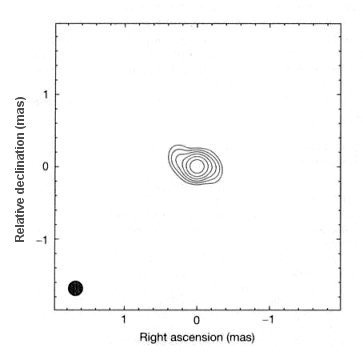 |
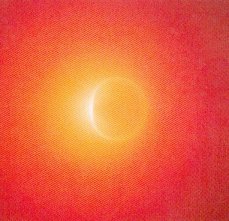 |
and centered on the Milky Way black hole, was measured by the Very long Baseline Array, which is a system of ten radio telescopes scattered across the United States. Figure 05-17f shows a super-resolution image with a circular beam of 0.2 mas (major axis size) from which an east-west elongated structure can be seen. The Schwarzschild radius Rs is 1.2 x 1012 cm according to the latest estimated value for the mass of the central black hole (~ 4 x 106 Msun). Thus, the size of the unresolved beam (the circle) is 2.5 Rs with the black hole just hidden inside. A 2007 measurement at a wavelength of 1.3 mm (which offers better resolution and |
Figure 05-17f Radio SgrA* [view large image] |
Figure 05-17g BH Shadow |
hence finer detail) indicates that SgrA* arises in a region offset from the central black hole. |
 |
It is suggested that the appearance of a black hole would be similar to the rendering shown in Figure 05-17g. The event horizon of a black hole completely absorbs emissions from matter behind when viewed from Earth. The result is a darker circle that could be seen in a sufficiently high-resolution image. The tendency of photons to be flung around the black hole in the direction of its rotation brings about an event-horizon shadow that is off-center, to the right in this picture. A brighter ring around the shadow is formed by light rays, which are strongly deflected by the gravitational pull of the black hole without being absorbed by it. The real image of a black hole has been captured sitting at the center of the face-on spiral galaxy NGC1097 (Figure 05-17h). |
Figure 05-17h NGC1097 |
It is a view looking down from the top. Matter is falling in from bars of stars and gas. The black hole is surrounded by hot gas and bright stars. This mysterious object is completely obscure by the jet stream (in green color) shooting out toward the viewing direction. |
 |
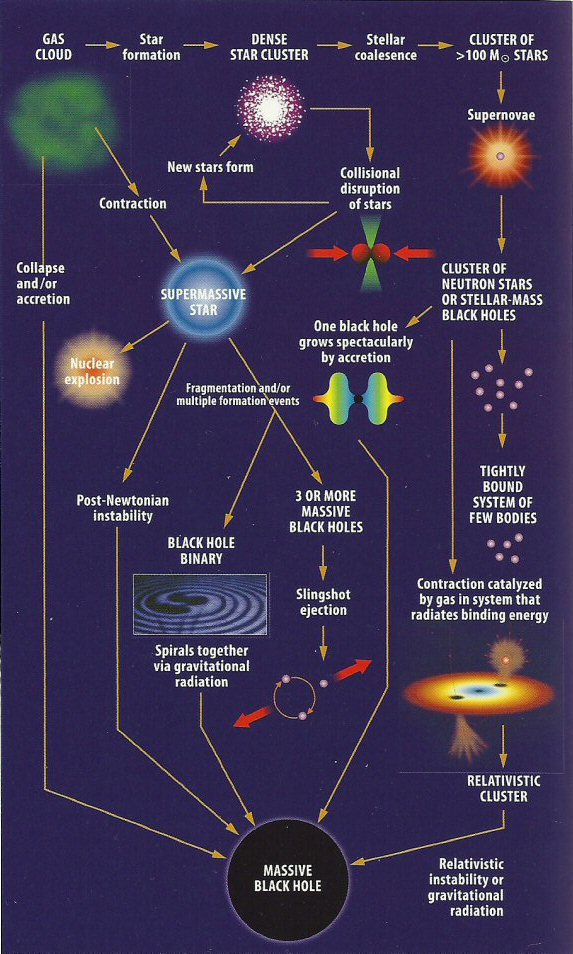 |
 |
Farther out are clouds and curtains of interstellar dust, which reflect the light from flares occurring when gas falls into the black hole. The region is also home to some very young, very dense star clusters (the blue stars at the upper left). Another artist's rendition in Figure 05-17j depicts the various objects and processes near a massive black hole. Figure 05-17k depicts 8 star tracks near the Milky Way Center. These orbits are painstakingly |
Figure 05-17i Milky Way Center [view large image] |
Figure 05-17j Sgr Objects |
Figure 05-17k MW Center, Star Tracks [view large image] |
stitched together by ancient records and modern data from adaptive optics. The mass and size of the central object asserts that it has to be a black hole. |
 |
Figure 05-17l Milkyway Centre Zoom In [view large image] |
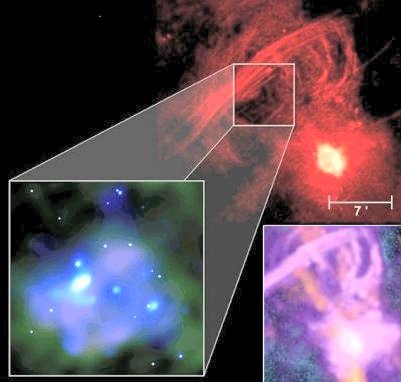 |
Figure 05-17l depicts a sequence of images to zoom in to the centre of the Milky Way utilizing the penetration power of different kinds of electromagnetic wave. The size of the region or object is indicted for each frame. Figure 05-17m is a blowup of frame # 3 in Figure 05-17l with radio image in red, X-ray image in blue. It shows the radio arc jutting straight out from the Galactic plane and a zoom in view of the Arches, which is the most compact cluster of stars known in the Milky Way. One hypothesis holds that the Radio Arc and the Arches have such geometrical shapes because they contain hot plasma flowing along lines of constant magnetic field. Images from the Chandra X-ray Observatory appear to show this plasma colliding with a nearby cloud of cold gas. The black hole at the Galactic center is hidden inside the bright radio structure. The insert at the lower right is imaged at 20 cm (purple) with the NRAO Very Large Array, tracing H II regions that are illuminated by hot, massive stars, supernova remnants, and synchrotron emission. Emission at 1.1 mm (orange) was observed with the Caltech Submillimeter |
Figure 05-17m Radio Arc |
Observatory and highlights cold (20-30 K) dust associated with molecular gas. Some of this material will form stars within in the next few million years; the remainder will be blown away (Image courtesy of NRAO/AUI). |
 |
The G2 cloud passed the periapse of the Milky Way center on May 2014 at a distance of about 200 A.U (~ distance to the Kuiper belt). It survived the closest encounter and failed to trigger a major flare up in the black hole's activity. It is suggested that there is a low mass object to hold together the cloud preventing its total disruption as predicted by many models. Since its emission is similar to that from the dust, it has been identified as a planetary embryo somehow ejected from the central star (among other suggestions). It would have a mass of about 10 to 100 times that of Jupiter and a size of about 1 A.U. Figure 05-17o shows the trajectory of the G2 cloud from 2006 to 2014 (red represents recessing and blue for approaching to the observer). |
Figure 05-17o G2 Encounter |
 |
On July 2012 NASA's Nuclear Spectroscopic Telescope Array (NuSTAR) has captured the flare up of X-ray during a period of 2 days at SgrA* (see time-lapse images on the right of Figure 05-17p). Such event is interpreted as the sign of material falling into the black hole. In this case the material could be gas from a nearby supernova remnant. The X-ray image at the center of the picture has been converted to visual colors with blue for 10 - 30 kev, green for 7 - 10 kev, and red for 3 - 7 kev. The time series shows X-ray energies between 3 - 30 kev corresponding to a temperature of about 100 million oC. NuSTAR is a space-based X-ray telescope operating in the range of 5 to 80 keV. It was successfully launched on 13 June 2012. Its primary scientific goals are to conduct a deep survey for black holes a billion times more massive than the sun, understand |
Figure 05-17p X-ray from SgrA* [view large image] |
how particles are accelerated to within a fraction of a percent below the speed of light in active galaxies, and learn how the elements are created in the explosions of massive stars by imaging the remains, which are called supernova remnants. |
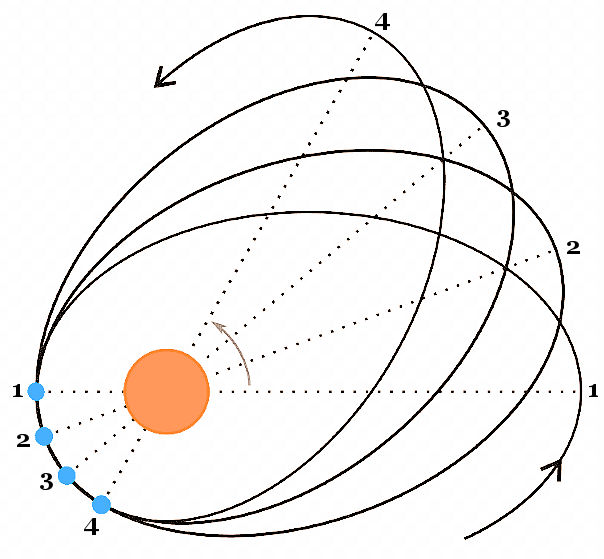 |
 |
It was known back in the 19 Century that Mercury's perihelion advances (Figure 05-17q) by an amount of about 5.74" (arcsec) per year. Newtonian mechanics at that time failed to account for a residual of 0.43"/yr after taking into consideration of all kinds of perturbations. The discrepancy is neatly resolved by Einstein's Theory of General Relativity in 1915, it is one of the tests to confirm that newly proposed theory. (see "Tests of General Relativity"). A modern version of the perihelion test is provided by the S2 star orbiting around the central black hold of the Milky Way (Figure 05-17r). Observation of its motion for 27 years has culminated in a publication entitled "Detection of the Schwarzschild precession in the orbit of the star S2 near the Galactic centre massive black hole". |
Figure 05-17q Perihelion of Mercury [view large image] |
Figure 05-17r S2 Orbital Motion [view large image, and video] |
The observations capture the amount of perihelion advance as well as the gravitational red shift to verify that the central object has a mass of about 4 million MSun. |
 |
 = 6 = 6 GM/[c2a(1 - e2)] ---------- (1a) or M = GM/[c2a(1 - e2)] ---------- (1a) or M =  [c2a(1 - e2)]/6 [c2a(1 - e2)]/6 GM ---------- (1b), GM ---------- (1b),where M is the mass of the central object, a the semi-major axis, and e is the eccentricity of the ellipse (G, c has its usual meaning).  = 12'/period = 3.4x10-3 radian/period, = 12'/period = 3.4x10-3 radian/period, |
Figure 05-17s Milky Way BH Mass [view large image] |
Figure 05-17s shows the estimates of the central black hole mass over the years. It seems to converge to M = 4x106 MSun |

 /
/ = 2x107/c. ----- (2)
= 2x107/c. ----- (2) =
=  0/(1 - RS/Ravg) ----- (3),
0/(1 - RS/Ravg) ----- (3), = 1o =
= 1o =  /180 = 0.0175 radian, then the distance s covered by the star in t = 8 years = 8 x 3.15 x 107 sec is given by:
/180 = 0.0175 radian, then the distance s covered by the star in t = 8 years = 8 x 3.15 x 107 sec is given by: = 0.875 x 1016cm
= 0.875 x 1016cm